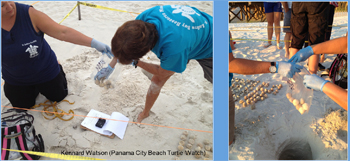Grant: 13-028R
Project Title: Integrating Stable Isotope Analysis and Hatchling Productivity Assessments to Infer Relative Importance of Loggerhead Foraging Areas
Project Manager: Dr. L.M. Ehrhart & Simona Ceriani
Organization: University of Central Florida (Research and Educational Institute)
Grant Amount: $35,211.00
Completion Date: 2014-12-19
Summary: In recent years, there has been growing interest in using stable isotopes as a tool to study migratory connectivity and identify foraging areas of marine turtles. Sampling on the nesting beach is relatively easy as the turtles are accessible to researchers. Recently, using a combination of satellite telemetry and stable isotope analysis, we demonstrated that red blood cells and un-hatched eggs can be used to assign foraging areas of loggerheads nesting at the Archie Carr NWR, Florida (Ceriani et al. 2012, Ceriani et al. in prep). Florida hosts ~90% of all the loggerhead nesting activity in the SE USA, yet few research groups encounter nesting females at night. In contrast, thousands of nests are marked to assess hatchling production through an extensive nesting survey program in Florida. In this proposal, we seek funding to analyze non-viable eggs from a subsample of loggerhead nests that will be marked as a part of the hatchling productivity assessment program conducted by FWRI in 2013. Non-viable eggs will be collected at time of excavation and frozen for stable isotope analysis and other potential contaminants. We will use the same unbiased sampling protocol used by FWRI to obtain samples that are representative of the loggerhead population nesting in Florida. This study will provide a non-invasive and non-destructive method of sampling a relatively large percentage of the loggerhead population nesting in Florida.  Results: The Sea Turtle Grant Program provided funds to collect and analyze non-viable eggs from a subsample of loggerhead nests (n=200) that were marked as a part of the hatchling productivity assessment program conducted by FWRI in 2013. This project relied on the established Florida permit-holder system. We used the same unbiased sampling protocol used by FWRI to obtain samples that are representative of the loggerhead population nesting in Florida. Our sampling design was based on the relative nesting importance of the five geographic areas used in the FWRI sampling scheme and involved several collaborators. Even though we received funding to analyze eggs from 200 nests, we sampled a larger number of nests to account for unforeseen shipping, laboratory and analysis problems and environmental stochasticity. Samples were analyzed according to schedule. We presented a poster at the 34th ISTS in New Orleans summarizing the results of the work. This study represents the first comprehensive geographic assessment of foraging areas use by loggerhead nesting in Florida. The results of the assignment model were congruent with previous satellite telemetry conducted in Florida (e.g., Girard et al. 2009, Ceriani et al. 2012, Dodd and Byles 2003, Foley et al. 2013, Hart et al. 2012, Tucker et al. 2014). The Caribbean and the Gulf of Mexico are prime foraging areas for loggerheads nesting in Florida and are extensively used by at least three of the four regional rookery groupings identified by Shamblin et al. (2011). Loggerheads nest every 1-4 years. Thus, one year of sampling most likely does not represent adequately the contribution of each foraging area. The license plate grant is funding a second year of the project and we will seek funding elsewhere for the 2015 nesting season. We aim to publish a paper including at least three years of data. Being able to analyze a representative sample of the annual nesting population may aid the interpretation of nesting trends and may help identifying foraging areas exposed to different threats. As conservation funding is limited, understanding relative importance of foraging areas to the overall nesting aggregation is important to prioritize conservation efforts.
Results: The Sea Turtle Grant Program provided funds to collect and analyze non-viable eggs from a subsample of loggerhead nests (n=200) that were marked as a part of the hatchling productivity assessment program conducted by FWRI in 2013. This project relied on the established Florida permit-holder system. We used the same unbiased sampling protocol used by FWRI to obtain samples that are representative of the loggerhead population nesting in Florida. Our sampling design was based on the relative nesting importance of the five geographic areas used in the FWRI sampling scheme and involved several collaborators. Even though we received funding to analyze eggs from 200 nests, we sampled a larger number of nests to account for unforeseen shipping, laboratory and analysis problems and environmental stochasticity. Samples were analyzed according to schedule. We presented a poster at the 34th ISTS in New Orleans summarizing the results of the work. This study represents the first comprehensive geographic assessment of foraging areas use by loggerhead nesting in Florida. The results of the assignment model were congruent with previous satellite telemetry conducted in Florida (e.g., Girard et al. 2009, Ceriani et al. 2012, Dodd and Byles 2003, Foley et al. 2013, Hart et al. 2012, Tucker et al. 2014). The Caribbean and the Gulf of Mexico are prime foraging areas for loggerheads nesting in Florida and are extensively used by at least three of the four regional rookery groupings identified by Shamblin et al. (2011). Loggerheads nest every 1-4 years. Thus, one year of sampling most likely does not represent adequately the contribution of each foraging area. The license plate grant is funding a second year of the project and we will seek funding elsewhere for the 2015 nesting season. We aim to publish a paper including at least three years of data. Being able to analyze a representative sample of the annual nesting population may aid the interpretation of nesting trends and may help identifying foraging areas exposed to different threats. As conservation funding is limited, understanding relative importance of foraging areas to the overall nesting aggregation is important to prioritize conservation efforts.